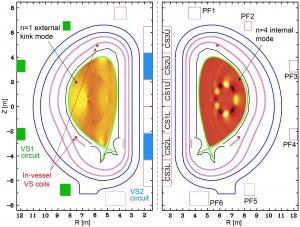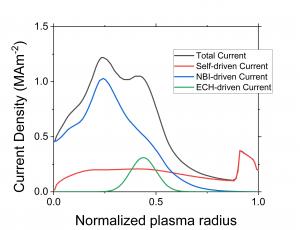Steady-state tokamak operation presents the advantage of having just two transient mechanical (forces) and thermal (heat-up/cool-down) events—switch-on and switch-off—over a very long period of continuous operation, however it is not an easy regime to reach. While other magnetic confinement systems such as stellarators are intrinsically steady state, reaching steady-state H-mode operation in a tokamak requires a delicate optimization of plasma conditions through operational control.
"By controlling the evolution of the plasma density and plasma current, you can establish a plasma current profile shape near what is needed to have a stable plasma in steady state, but at lower temperatures and pressures. This makes things easier," explains Loarte. "Then you add a lot of auxiliary heating to create the transition to H-mode, and you increase the plasma pressure to enhance the self-driven plasma current and current drive to replace the remaining inductive current. The current shape profile remains frozen due to the high temperatures, ensuring that the plasma remains stable at high pressures. That's the trick you have to pull off."
During the design phases of ITER, it was thought that a dedicated heating system, using so-called lower hybrid waves, would be required to reach steady-state operation. The project plan was to move another piece of equipment out of a port when the time came to run the steady-state experiments, in order to install the lower hybrid heating system.
No one was completely comfortable with this idea. Moving systems between ports in ITER is very complex and disruptive for a number of reasons: the port plugs that house the system must be extracted and re-inserted, the pipes and transmission lines that feed the systems in the ports must be disconnected and reconnected, etc. ITER scientists were looking for a better solution.
Breakthrough findings indicate ITER can reach steady state with the same heating systems that are being built now
The good news came with the recent demonstration that steady-state H-mode could be achieved at ITER without adding the lower hybrid wave heating and current drive system.
"Using integrated modelling, we set out to show that we can control core plasma stability in this scenario with the baseline heating and current drive mix at ITER," says Alexei Polevoi, from the Plasma Modelling & Analysis Section. "By the use of neutral beam injection and electron cyclotron wave heating and current drive, we demonstrated that it's possible to reach the target operation point, where steady state is reached, within the limits of the magnet systems that ITER has. We determined that an upgrade of the neutral beam injection system (to 49.5 MW, versus the baseline of 33 MW) and the electron cyclotron heating system (to 30 MW, versus the baseline of 20 MW) would be required to make Q=5 steady-state operation, with reasonable assumptions regarding the achievable energy confinement."



